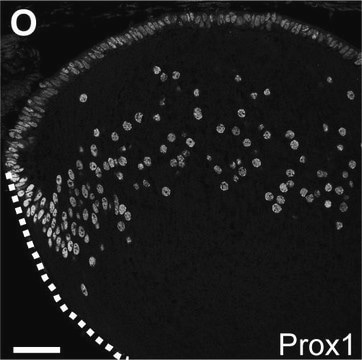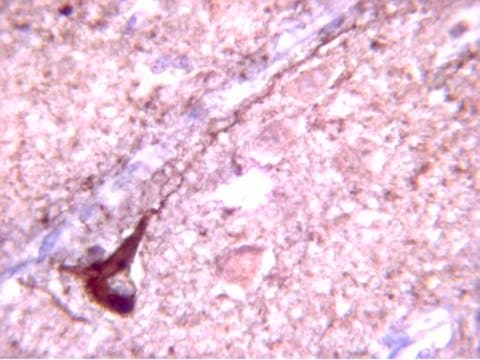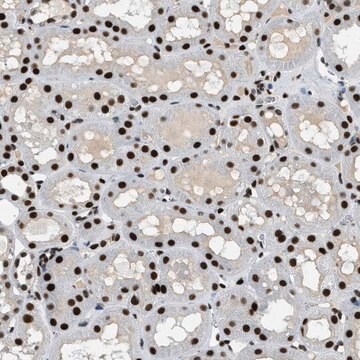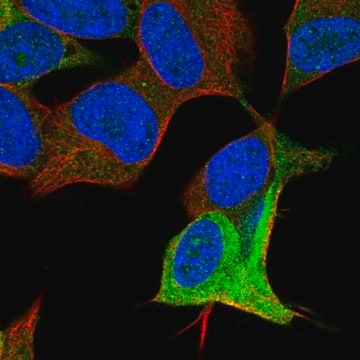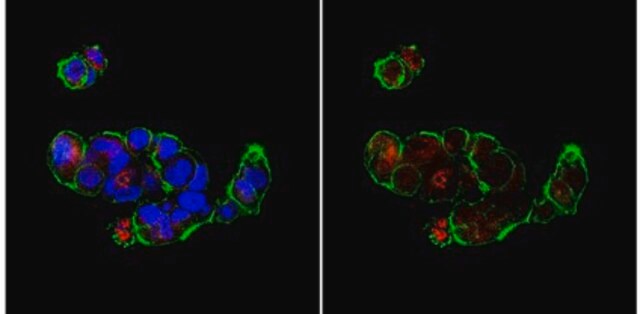추천 제품
생물학적 소스
mouse
Quality Level
항체 형태
purified antibody
항체 생산 유형
primary antibodies
클론
4G10, monoclonal
종 반응성
chicken, mouse, rat, human, lizard
제조업체/상표
Chemicon®
기술
immunohistochemistry: suitable
western blot: suitable
동형
IgG
NCBI 수납 번호
UniProt 수납 번호
배송 상태
wet ice
타겟 번역 후 변형
unmodified
유전자 정보
mouse ... Prox1(19130)
특이성
Prox1. By Western blot the antibody recognizes a ~83 kDa protein in fetal mouse brain lysate.
면역원
Recombinant human Prox1 protein.
애플리케이션
Anti-Prox1 Antibody, clone 4G10 is an antibody against Prox1 for use in WB, IH.
Research Category
Neuroscience
Neuroscience
Research Sub Category
Developmental Neuroscience
Neuronal & Glial Markers
Developmental Neuroscience
Neuronal & Glial Markers
Western blot: 2 μg/mL
Optimal working dilutions must be determined by end user.
Optimal working dilutions must be determined by end user.
표적 설명
83 kDa
결합
Replaces: MABE488
물리적 형태
Format: Purified
Liquid in PBS with 0.1% sodium azide.
Protein A purified
저장 및 안정성
Maintain at 2-8degC in undiluted aliquots for up to 6 months after date of receipt.
법적 정보
CHEMICON is a registered trademark of Merck KGaA, Darmstadt, Germany
면책조항
Unless otherwise stated in our catalog or other company documentation accompanying the product(s), our products are intended for research use only and are not to be used for any other purpose, which includes but is not limited to, unauthorized commercial uses, in vitro diagnostic uses, ex vivo or in vivo therapeutic uses or any type of consumption or application to humans or animals.
Not finding the right product?
Try our 제품 선택기 도구.
Storage Class Code
10 - Combustible liquids
WGK
WGK 2
Flash Point (°F)
Not applicable
Flash Point (°C)
Not applicable
시험 성적서(COA)
제품의 로트/배치 번호를 입력하여 시험 성적서(COA)을 검색하십시오. 로트 및 배치 번호는 제품 라벨에 있는 ‘로트’ 또는 ‘배치’라는 용어 뒤에서 찾을 수 있습니다.
Julia Holzmann et al.
Developmental neurobiology, 75(12), 1352-1367 (2015-03-20)
Neurogenesis in embryonic sympathetic ganglia involves neuroblasts that resume proliferation following neuronal differentiation. As cell cycle exit is not associated with neuronal differentiation, the identity of proliferating neuroblasts is incompletely understood. Here, we use sympathetic ganglia of chick embryos to
Shogo Yoshihara et al.
Cell reports, 35(2), 108971-108971 (2021-04-15)
In schizophrenia (SCZ), neurons in the brain tend to undergo gross morphological changes, but the related molecular mechanism remains largely elusive. Using Kif3b+/- mice as a model with SCZ-like behaviors, we found that a high-betaine diet can significantly alleviate schizophrenic
Rebecca S Lescarbeau et al.
Molecular cancer therapeutics, 15(6), 1332-1343 (2016-05-20)
Glioblastoma (GBM) is the most common malignant primary brain cancer. With a median survival of about a year, new approaches to treating this disease are necessary. To identify signaling molecules regulating GBM progression in a genetically engineered murine model of
Chih-Hao Yang et al.
Cell reports, 30(4), 959-968 (2020-01-30)
In the adult brain, new dentate granule cells integrate into neural circuits and participate in hippocampal functioning. However, when and how they initiate this integration remain poorly understood. Using retroviral and live-imaging methods, we find that new neurons undergo neurite remodeling for
Jennifer Yejean Kim et al.
Frontiers in neuroscience, 16, 816174-816174 (2022-04-12)
Alzheimer's disease (AD) is the most common condition in patients with dementia and affects a large population worldwide. The incidence of AD is expected to increase in future owing to the rapid expansion of the aged population globally. Researchers have
자사의 과학자팀은 생명 과학, 재료 과학, 화학 합성, 크로마토그래피, 분석 및 기타 많은 영역을 포함한 모든 과학 분야에 경험이 있습니다..
고객지원팀으로 연락바랍니다.

